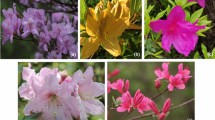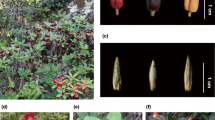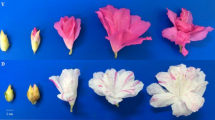Abstract
Flower color variation is ubiquitous in many plant species, and several studies have been conducted to elucidate the underlying molecular mechanism. There are two flower color variants (yellowish-white and fuchsia) in the Rheum palmatum complex, however, few studies have investigated this phenomenon. Here, we used transcriptome sequencing of the two color variants to shed light on the molecular and biochemical basis for these color morphs. Comparison of the two transcriptomes identified 9641 differentially expressed unigenes (DEGs), including 6477 up-regulated and 3163 down-regulated genes. Functional analyses indicated that several DEGs were related to the anthocyanin biosynthesis pathway, and the expression profiles of these DEGs were coincident with the qRT-PCR validation results, indicating that expression levels of structural genes have a profound effect on the color variation in the R. palmatum complex. Our results suggested that the interaction of transcription factors (MYB, bHLH and WRKY) also regulated the anthocyanin biosynthesis in the R. palmatum complex. Estimation of selection pressures using the dN/dS ratio showed that 1106 pairs of orthologous genes have undergone positive selection. Of these positively selected genes, 21 were involved in the anthocyanin biosynthetic pathway, indicating that they may encode the proteins for structural alteration and affect flower color in the R. palmatum complex.
Key message
Comparative transcriptome indicated that the flower color of R. palmatum complex was co-regulated by the expression profiles of genes and transcript factors involved in anthocyanin synthesis and natural selection.




Similar content being viewed by others
Data availability
All the raw reads generated in this study have been deposited in the NCBI with the BioProject Accession Number of PRJNA735904.
References
Altschul SF, Madden TL, Schäffer AA, Zhang J, Zhang Z, Miller W, Lipman DJ (1997) Gapped BLAST and PSI-BLAST: a new generation of protein database search programs. Nucleic Acids Res 25(17):3389–3402. https://doi.org/10.1093/nar/25.17.3389
Anders S, Huber W (2010) Differential expression analysis for sequence count data. Genome Biol 11(10):R106. https://doi.org/10.1186/gb-2010-11-10-r106
Casimiro-Soriguer I, Narbona E, Buide ML, Del Valle JC, Whittall JB (2016) Transcriptome and biochemical analysis of a flower color polymorphism in Silene littorea (Caryophyllaceae). Front Plant Sci 7:204–204. https://doi.org/10.3389/fpls.2016.00204
Chen Y, Mao Y, Liu H, Yu F, Li S, Yin T (2014) Transcriptome analysis of differentially expressed genes relevant to variegation in peach flowers. PLoS ONE 9(3):e90842. https://doi.org/10.1371/journal.pone.0090842
Chen C, Chen H, Zhang Y, Thomas HR, Frank MH, He Y, Xia R (2020) TBtools: an integrative toolkit developed for interactive analyses of big biological data. Mol Plant 13(8):1194–1202. https://doi.org/10.1016/j.molp.2020.06.009
Chinese Pharmacopoeia Committee (2020) Pharmacopoeia of the People’s Republic of China, Part 1. China Medical Science Press, Beijing
Clegg MT, Durbin ML (2000) Flower color variation: a model for the experimental study of evolution. Proc Natl Acad Sci USA 97(13):7016–7023. https://doi.org/10.1073/pnas.97.13.7016
Davies KM, Schwinn KE, Deroles SC, Manson DG, Lewis DH, Bloor SJ, Bradley JM (2003) Enhancing anthocyanin production by altering competition for substrate between flavonol synthase and dihydroflavonol 4-reductase. Euphytica 131(3):259–268. https://doi.org/10.1023/A:1024018729349
Davies KM, Albert NW, Schwinn KE (2012) From landing lights to mimicry: the molecular regulation of flower colouration and mechanisms for pigmentation patterning. Funct Plant Biol 39(8):619–638. https://doi.org/10.1071/FP12195
Durbin ML, Lundy KE, Morrell PL, Torres-Martinez CL, Clegg MT (2003) Genes that determine flower color: the role of regulatory changes in the evolution of phenotypic adaptations. Mol Phylogenet Evol 29(3):507–518. https://doi.org/10.1016/S1055-7903(03)00196-9
Emms DM, Kelly S (2019) OrthoFinder: phylogenetic orthology inference for comparative genomics. Genome Biol 20(1):238. https://doi.org/10.1186/s13059-019-1832-y
Forkmann G, De Vlaming P, Spribille R, Wiering H, Schram A (1986) Genetic and biochemical studies on the conversion of dihydroflavonols to flavonols in flowers of Petunia hybrida. Z Naturforsch C 41(1–2):179–186. https://doi.org/10.1515/znc-1986-1-227
Fu L, Niu B, Zhu Z, Wu S, Li W (2012) CD-HIT: accelerated for clustering the next-generation sequencing data. Bioinformatics 28(23):3150–3152. https://doi.org/10.1093/bioinformatics/bts565
Gao Q, Luo H, Li Y, Liu Z, Kang C (2020) Genetic modulation of RAP alters fruit coloration in both wild and cultivated strawberry. Plant Biotechnol J 18(7):1550–1561. https://doi.org/10.1111/pbi.13317
Garg R, Jain M (2013) RNA-Seq for transcriptome analysis in non-model plants. In: Rose RJ (ed) Legume genomics: methods and protocols. Humana Press, Totowa, pp 43–58. https://doi.org/10.1007/978-1-62703-613-9_4
Giusti MM, Wrolstad RE (2001) Characterization and measurement of anthocyanins by UV-visible spectroscopy. Curr Protoc Food Anal Chem. https://doi.org/10.1002/0471142913.faf0102s00
Goto T, Kondo T (1991) Structure and molecular stacking of anthocyanins—flower color variation. Angew Chem Int Ed Engl 30(1):17–33. https://doi.org/10.1002/anie.199100171
Grabherr MG, Haas BJ, Yassour M, Levin JZ, Thompson DA, Amit I, Adiconis X, Fan L, Raychowdhury R, Zeng Q (2011) Full-length transcriptome assembly from RNA-Seq data without a reference genome. Nat Biotechnol 29(7):644–652. https://doi.org/10.1038/nbt.1883
Hichri I, Barrieu F, Bogs J, Kappel C, Delrot S, Lauvergeat V (2011) Recent advances in the transcriptional regulation of the flavonoid biosynthetic pathway. J Exp Bot 62(8):2465–2483. https://doi.org/10.1093/jxb/erq442
Holton TA, Cornish EC (1995) Genetics and biochemistry of anthocyanin biosynthesis. Plant Cell 7(7):1071–1083. https://doi.org/10.1105/tpc.7.7.1071
Hopkins R, Rausher MD (2011) Identification of two genes causing reinforcement in the Texas wildflower Phlox drummondii. Nature 469(7330):411–414. https://doi.org/10.1038/nature09641
Huang B, Rong H, Ye Y, Ni Z, Xu M, Zhang W, Xu L-A (2020) Transcriptomic analysis of flower color variation in the ornamental crabapple (Malus spp.) half-sib family through Illumina and PacBio Sequel sequencing. Plant Physiol Biochem 149:27–35. https://doi.org/10.1016/j.plaphy.2020.01.033
Koes R, Verweij W, Quattrocchio F (2005) Flavonoids: a colorful model for the regulation and evolution of biochemical pathways. Trends Plant Sci 10(5):236–242. https://doi.org/10.1016/j.tplants.2005.03.002
Langmead B, Trapnell C, Pop M, Salzberg SL (2009) Ultrafast and memory-efficient alignment of short DNA sequences to the human genome. Genome Biol 10(3):R25. https://doi.org/10.1186/gb-2009-10-3-r25
Li B, Dewey CN (2011) RSEM: accurate transcript quantification from RNA-Seq data with or without a reference genome. BMC Bioinform 12:323–323. https://doi.org/10.1186/1471-2105-12-323
Li Y, Luo X, Wu C, Cao S, Zhou Y, Jie B, Cao Y, Meng H, Wu G (2018) Comparative transcriptome analysis of genes involved in anthocyanin biosynthesis in red and green walnut (Juglans regia L.). Molecules 23(1):25. https://doi.org/10.3390/molecules23010025
Li L, Zhai Y, Luo X, Zhang Y, Shi Q (2019) Comparative transcriptome analyses reveal genes related to pigmentation in the petals of red and white Primula vulgaris cultivars. Physiol Mol Biol Plants 25(4):1029–1041
Li F, Wu B, Yan L, Qin X, Lai J (2021) Metabolome and transcriptome profiling of Theobroma cacao provides insights into the molecular basis of pod color variation. J Plant Res 134(6):1323–1334. https://doi.org/10.1007/s10265-021-01338-9
Liang W, Ni L, Carballar-Lejarazú R, Zou X, Sun W, Wu L, Yuan X, Mao Y, Huang W, Zou S (2019) Comparative transcriptome among Euscaphis konishii Hayata tissues and analysis of genes involved in flavonoid biosynthesis and accumulation. BMC Genomics 20(1):24. https://doi.org/10.1186/s12864-018-5354-x
Liu X, Zhao C, Gong Q, Wang Y, Cao J, Li X, Grierson D, Sun C (2020) Characterization of a caffeoyl-CoA O-methyltransferase-like enzyme involved in biosynthesis of polymethoxylated flavones in Citrus reticulata. J Exp Bot 71(10):3066–3079. https://doi.org/10.1093/jxb/eraa083
Lloyd A, Brockman A, Aguirre L, Campbell A, Bean A, Cantero A, Gonzalez A (2017) Advances in the MYB–bHLH–WD repeat (MBW) pigment regulatory model: addition of a WRKY factor and co-option of an anthocyanin MYB for betalain regulation. Plant Cell Physiol 58(9):1431–1441. https://doi.org/10.1093/pcp/pcx075
Lowe R, Shirley N, Bleackley M, Dolan S, Shafee T (2017) Transcriptomics technologies. PLoS Comput Biol 13(5):e1005457. https://doi.org/10.1371/journal.pcbi.1005457
Lu J, Zhang Q, Lang L, Jiang C, Wang X, Sun H (2021) Integrated metabolome and transcriptome analysis of the anthocyanin biosynthetic pathway in relation to color mutation in miniature roses. BMC Plant Biol 21(1):257. https://doi.org/10.1186/s12870-021-03063-w
Meng L, Qi C, Wang C, Wang S, Zhou C, Ren Y, Cheng Z, Zhang X, Guo X, Zhao Z, Wang J, Lin Q, Zhu S, Wang H, Wang Z, Lei C, Wan J (2021) Determinant factors and regulatory systems for anthocyanin biosynthesis in rice apiculi and stigmas. Rice 14(1):37. https://doi.org/10.1186/s12284-021-00480-1
Morohashi K, Casas MI, Falcone Ferreyra ML, Mejía-Guerra MK, Pourcel L, Yilmaz A, Feller A, Carvalho B, Emiliani J, Rodriguez E, Pellegrinet S, McMullen M, Casati P, Grotewold E (2012) A genome-wide regulatory framework identifies maize Pericarp Color1 controlled genes. Plant Cell 24(7):2745–2764. https://doi.org/10.1105/tpc.112.098004
Patel RK, Jain M (2012) NGS QC Toolkit: a toolkit for quality control of next generation sequencing data. PLoS ONE 7(2):e30619. https://doi.org/10.1371/journal.pone.0030619
Pourcel L, Irani NG, Lu Y, Riedl K, Schwartz S, Grotewold E (2010) The formation of anthocyanic vacuolar inclusions in Arabidopsis thaliana and implications for the sequestration of anthocyanin pigments. Mol Plant 3(1):78–90. https://doi.org/10.1093/mp/ssp071
Pu X, Li Z, Tian Y, Gao R, Hao L, Hu Y, He C, Sun W, Xu M, Peters RJ, Van de Peer Y, Xu Z, Song J (2020) The honeysuckle genome provides insight into the molecular mechanism of carotenoid metabolism underlying dynamic flower coloration. New Phytol 227:930–943. https://doi.org/10.1111/nph.16552
Rice P, Longden I, Bleasby A (2000) EMBOSS: the European molecular biology open software suite. Trends Genet 16(6):276–277. https://doi.org/10.1016/S0168-9525(00)02024-2
Roberts WR, Roalson EH (2017) Comparative transcriptome analyses of flower development in four species of Achimenes (Gesneriaceae). BMC Genomics 18(1):240. https://doi.org/10.1186/s12864-017-3623-8
Roda F, Mendes FK, Hahn MW, Hopkins R (2017) Genomic evidence of gene flow during reinforcement in Texas Phlox. Mol Ecol 26(8):2317–2330. https://doi.org/10.1111/mec.14041
Rozen S, Skaletsky H (1999) Primer3 on the WWW for general users and for biologist programmers. In: Bioinformatics methods and protocols. Springer, Cham, pp 365–386
Schemske DW, Bierzychudek P (2001) Perspective: evolution of flower color in the desert annual Linanthus parryae: Wright revisited. Evolution 55(7):1269–1282. https://doi.org/10.1111/j.0014-3820.2001.tb00650.x
Schmittgen TD, Livak KJ (2008) Analyzing real-time PCR data by the comparative CT method. Nat Protoc 3(6):1101–1108. https://doi.org/10.1038/nprot.2008.73
Singh P, Rawat M (2016) Phytochemistry and biological activity perspectives of Rheum species. Nat Prod J 6(2):84–93. https://doi.org/10.2174/2210315506666151208212726
Sobral M, Guitian J, Guitian P, Larrinaga AR (2013) Selective pressure along a latitudinal gradient affects subindividual variation in plants. PLoS ONE 8(9):e74356. https://doi.org/10.1371/journal.pone.0074356
Suzuki S, Nishihara M, Nakatsuka T, Misawa N, Ogiwara I, Yamamura S (2007) Flower color alteration in Lotus japonicus by modification of the carotenoid biosynthetic pathway. Plant Cell Rep 26(7):951–959. https://doi.org/10.1007/s00299-006-0302-7
Tanaka Y, Brugliera F (2013) Flower colour and cytochromes P450. Philos T R Soc B 368(1612):20120432. https://doi.org/10.1098/rstb.2012.0432
Tanaka Y, Sasaki N, Ohmiya A (2008) Biosynthesis of plant pigments: anthocyanins, betalains and carotenoids. Plant J 54(4):733–749. doi:https://doi.org/10.1111/j.1365-313X.2008.03447.x
Tanaka Y, Brugliera F, Kalc G, Senior M, Dyson B, Nakamura N, Katsumoto Y, Chandler S (2010) Flower color modification by engineering of the flavonoid biosynthetic pathway: practical perspectives. Biosci Biotechnol Biochem 74(9):1760–1769. https://doi.org/10.1271/bbb.100358
Tengkun N, Dongdong W, Xiaohui M, Yue C, Qin C (2019) Analysis of key genes involved in potato anthocyanin biosynthesis based on genomics and transcriptomics data. Front Plant Sci. https://doi.org/10.3389/fpls.2019.00603
Wang X-M, Hou X-Q, Zhang Y-Q, Li Y (2014) Morphological variation in leaf dissection of Rheum palmatum complex (Polygonaceae). PLoS ONE 9(10):e110760. https://doi.org/10.1371/journal.pone.0110760
Wang X, Feng L, Zhou T, Ruhsam M, Huang L, Hou X, Sun X, Fan K, Huang M, Zhou Y, Song J (2018) Genetic and chemical differentiation characterizes top-geoherb and non-top-geoherb areas in the TCM herb rhubarb. Sci Rep 8(1):9424. https://doi.org/10.1038/s41598-018-27510-1
Winkel-Shirley B (2001) Flavonoid biosynthesis. A colorful model for genetics, biochemistry, cell biology, and biotechnology. Plant Physiol 126(2):485–493. https://doi.org/10.1104/pp.126.2.485
Yang Y, Wang J, Ma Z, Sun G, Zhang C (2014) De novo sequencing and comparative transcriptome analysis of white petals and red labella in Phalaenopsis for discovery of genes related to flower color and floral differentiation. Acta Soc Bot Pol 83(3):191–199. https://doi.org/10.5586/asbp.2014.023
Yu G, Wang L-G, Han Y, He Q-Y (2012) clusterProfiler: an R package for comparing biological themes among gene clusters. Omics 16(5):284–287. https://doi.org/10.1089/omi.2011.0118
Zhang Z, Li J, Zhao X-Q, Wang J, Wong GK-S, Yu J (2006) KaKs_Calculator: calculating Ka and Ks through model selection and model averaging. Genomics Proteomics Bioinform 4(4):259–263. https://doi.org/10.1016/S1672-0229(07)60007-2
Zhang H, Jin J, Tang L, Zhao Y, Gu X, Gao G, Luo J (2010) PlantTFDB 2.0: update and improvement of the comprehensive plant transcription factor database. Nucleic Acids Res 39(suppl1):D1114–D1117. https://doi.org/10.1093/nar/gkq1141
Zhang Z, Xiao J, Wu J, Zhang H, Liu G, Wang X, Dai L (2012) ParaAT: a parallel tool for constructing multiple protein-coding DNA alignments. Biochem Biophys Res Commun 419(4):779–781. https://doi.org/10.1016/j.bbrc.2012.02.101
Zhang Q, Hao R, Xu Z, Yang W, Wang J, Cheng T, Pan H, Zhang Q (2017) Isolation and functional characterization of a R2R3-MYB regulator of Prunus mume anthocyanin biosynthetic pathway. Plant Cell Tissue Organ 131(3):417–429. https://doi.org/10.1007/s11240-017-1294-4
Zhang Y, Zhou T, Dai Z, Dai X, Li W, Cao M, Li C, Tsai W-C, Wu X, Zhai J (2020) Comparative transcriptomics provides insight into floral color polymorphism in a Pleione limprichtii orchid population. Int J Mol Sci 21(1):247. https://doi.org/10.3390/ijms21010247
Zhao J, Dixon RA (2010) The ‘ins’ and ‘outs’ of flavonoid transport. Trends Plant Sci 15(2):72–80. https://doi.org/10.1016/j.tplants.2009.11.006
Zhou T, Li Z, Bai G, Feng L, Chen C, Wei Y, Chang Y, Zhao G (2016) Transcriptome sequencing and development of genic SSR markers of an endangered Chinese endemic genus Dipteronia Oliver (Aceraceae). Molecules 21(3):166. https://doi.org/10.3390/molecules21030166
Zhou T, Zhu H, Wang J, Xu Y, Xu F, Wang X (2020) Complete chloroplast genome sequence determination of Rheum species and comparative chloroplast genomics for the members of Rumiceae. Plant Cell Rep 39(6):811–824. https://doi.org/10.1007/s00299-020-02532-0
Zhu Y, Bao Y (2021) Genome-wide mining of MYB transcription factors in the anthocyanin biosynthesis pathway of Gossypium hirsutum. Biochem Genet 59(3):678–696. https://doi.org/10.1007/s10528-021-10027-0
Acknowledgements
This study was co-supported by the National Natural Science Foundation of China (Nos. 81903739 and 31770364), the Natural Science Foundation of Shaanxi Province (Nos. 2020JQ-024 and 2020JZ-05) and the China Postdoctoral Science Foundation (No. 2018M643680). The Royal Botanic Garden Edinburgh is supported by the Scottish Government’s Rural and Environment Science and Analytical Services Division.
Author information
Authors and Affiliations
Contributions
TZ and XW conceived and designed the experiments. TZ collected samples. TZ, JS, YZ and CG performed the experiments and analyzed the data. TZ, MR and XW wrote the paper. All authors read and approved the final manuscript.
Corresponding author
Ethics declarations
Conflict of interest
All authors did not have any conflict of interest.
Research involving human and/or animal participants
This article does not contain any studies with human participants or animals performed by any of the authors.
Additional information
Publisher’s Note
Springer Nature remains neutral with regard to jurisdictional claims in published maps and institutional affiliations.
Supplementary Information
Below is the link to the electronic supplementary material.
11103_2022_1299_MOESM1_ESM.zip
Supplementary file1 (ZIP 9249 kb)—Figure S1 Top-hit species distribution for non-redundant unigene sequences against the NCBI-nr. database. Figure S2 Gene Ontology (GO) classification of non-redundant unigene sequences from the R. palmatum complex. Figure S3 The top 20 pathway terms enriched in the KEGG database for the DEGs between PL and ZK samples. The q-value indicates the significance of the rich factor ranging from 0 to 1. The circle size represents the number of DEGs. Figure S4 Distribution of transcription factors. Figure S5 Distribution of dN and dS for 6915 pairs of orthologs between ZK and PL samples. Red and green colored dots indicate genes that have undergone positive or negative selection, respectively. Table S1 Annotation information of all non-redundant unigenes in eight databases. Table S2 GO enrichment results of DEGs between PL and ZK samples. Table S3 Annotation results of DEGs between PL and ZK samples in eight databases. Table S4 dN, dS values and dN/dS ratio between orthologs of PL and ZK. Table S5 Annotation information of genes which have undergone positive selection. Table S6 Candidate genes involved in the biosynthesis of anthocyanins which have undergone positive selection.
Rights and permissions
Springer Nature or its licensor holds exclusive rights to this article under a publishing agreement with the author(s) or other rightsholder(s); author self-archiving of the accepted manuscript version of this article is solely governed by the terms of such publishing agreement and applicable law.
About this article
Cite this article
Zhou, T., Sun, J., Zhai, Y. et al. Transcriptome profiles of yellowish-white and fuchsia colored flowers in the Rheum palmatum complex reveal genes related to color polymorphism. Plant Mol Biol 110, 187–197 (2022). https://doi.org/10.1007/s11103-022-01299-0
Received:
Accepted:
Published:
Issue Date:
DOI: https://doi.org/10.1007/s11103-022-01299-0




